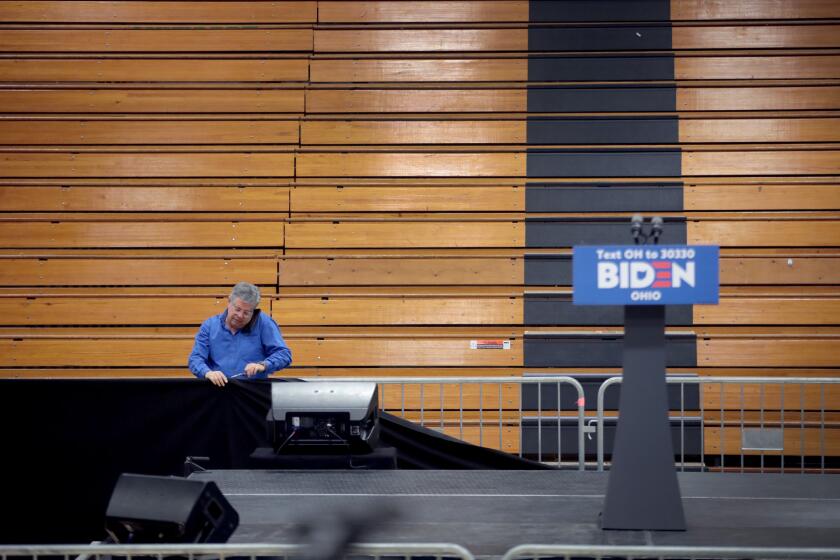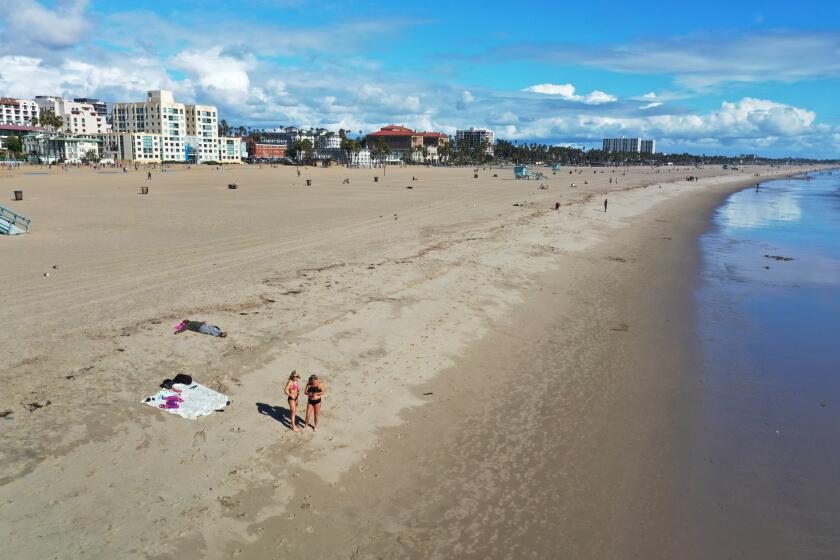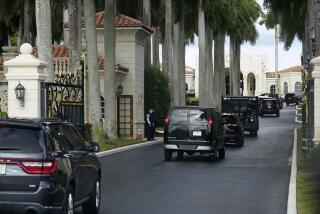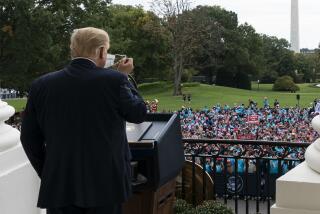Trump declares a national emergency over the coronavirus

WASHINGTON â President Trump declared a national emergency over the coronavirus outbreak Friday, which will allow more federal aid to flow to states and municipalities, as he sought for the second time in three days to reassure the country about his leadership.
At a news conference in the White House Rose Garden, the president made a number of undefined promises about expanded testing and bolstering the economy while batting away questions about the governmentâs slow-footed response to date.
âTo unleash the full power of the federal government, Iâm officially declaring a national emergency. Two very big words,â he said.
Trump also said he was âmost likelyâ to get a coronavirus test himself, although he maintained he had no symptoms and didnât actually need one. In recent days, the president has been in close proximity to at least one person who has tested positive for the virus and several others who have potentially been exposed.
And in a remark that is almost certain to figure in advertisements against him in this yearâs presidential campaign, Trump said, âI donât take any responsibility at allâ for the failures in the governmentâs response to the coronavirus crisis so far. His administration had inherited a flawed system, he said.
Moments later, he claimed not to know anything about his administrationâs 2018 decision to shut down the office within the National Security Council that was set up to coordinate the governmentâs response to pandemics.
âWhen you say âme,â I didnât do it,â he said, telling the reporter who asked about the subject that her question was ânasty.â
âYou say we did that; I donât know anything about it,â he said.
Because of the coronavirus, Joe Biden, Bernie Sanders, even President Trump, have stopped rallies. Louisiana postponed its presidential primary.
Trump had been under mounting pressure from Democrats to make an emergency declaration in order to free more than $40 billion in federal money for states.
The move will allow states to request a 75% federal cost-share for expenses related to virus response and mitigation efforts â including emergency workers, medical tests, medical supplies and vaccinations.
The president had been reluctant to make such a declaration, largely out of concern that it would contradict his numerous public statements over the last month that attempted to downplay concerns over the coronavirus.
At the news conference, he appeared with members of his coronavirus task force as well as CEOs of several major corporations who have worked with the government on a new, expedited testing system. He also shook hands with several of them, again exhibiting a behavior health officials warn can spread the virus.
Trump began by listing the actions he had already taken in response to the epidemic, but then pivoted.
âWeâre doing a tremendous job,â he said. âNow weâre in a different phase.â
Trump urged states to immediately set up emergency operations centers and vowed to âvastly increase and accelerate our capacity to testâ for the virus, addressing an issue that has become a serious logistical and political liability in recent days.
The new testing system will allow the U.S. to establish âdrive-throughâ centers similar to those currently in use in South Korea.
He did not address why his administration had not worked to set up such a system earlier, before the virus had spread through the country. And despite repeated questions, neither Trump, Vice President Mike Pence nor the other officials and executives present would commit to a specific date that the new tests would be available to the public.
Trump, who last week erroneously said that tests were available to anyone who wanted one, reiterated several times that not everyone should take the test and sought again to calm public fears about the pandemic.
âWe donât want everybody taking this test,â Trump said. âItâs totally unnecessary, and this will pass.â
Dr. Deborah Birx, the White Houseâs coronavirus response coordinator, also unveiled a new website developed in collaboration with Google to enable people with concerns about symptoms to determine whether they should seek a test.
Dr. Anthony Fauci, director of the National Institute of Allergy and Infectious Diseases, said that the additional testing and emergency declaration would help slow the spread of the virus.
Officials acknowledge that testing now is less important because the virus no longer can be contained. The focus of public health officials has shifted to efforts to reduce social contact in order to slow the pace at which the virus spreads and avoid overstressing the nationâs hospitals and other medical facilities.
âWhen you have an outbreak like this, particularly if youâre trying to interfere with it, itâs really impossible to predict a time element of when itâs going to peak and when itâs naturally going to go down,â Fauci said.
With the country desperate for clarity and direction as panic spreads, the president offered several vague responses to questions from reporters.
He refused to commit one way or another to additional government bailouts for the cruise ship industry and other sectors reeling from the pandemic. He claimed that the government has ordered additional ventilators to prepare for an influx of critical cases at the nationâs hospitals, but could not say when theyâd be in place.
He said that he might add the United Kingdom to the temporary ban on foreign travelers coming from Europe but did not say when a decision might be made.
Trump did outline two concrete measures heâs taking â waiving interest on federal student loans for an unspecified period and directing the Department of the Treasury to take advantage of low crude oil prices to replenish the strategic petroleum reserve.
With prices for crude oil crashing, oil industry lobbyists have been urging the government to buy up oil and place it in the reserve in the hope that those purchases will keep the price from dropping further.
The reserve was set up in 1975 to protect the U.S. against a cutoff of oil imports. Since the U.S. now is a net exporter of oil, the reserve no longer serves that purpose.
Roughly 90 minutes before the news conference began, House Speaker Nancy Pelosi (D-San Francisco) partially preempted Trump by making a public statement from the Capitol, outlining the legislation she has negotiated largely with Treasury Secretary Steven T. Mnuchin that, she said, would ensure that testing is free for all Americans, including the uninsured.
âWe can only defeat this outbreak if we have an accurate determination of its scale and scope,â Pelosi said.
Like former Vice President Joe Biden a day earlier, she delivered remarks standing in front of a row of American flags â a symbolic gesture by Democrats suggesting an eagerness to grasp the trappings of the presidency at a moment when Trumpâs leadership is under intense scrutiny.
Trump also spoke Friday with French President Emmanuel Macron, who tweeted that the Group of 7 leaders had agreed to take part in a video conference Monday to better coordinate efforts to slow the global pandemic and mitigate its sweeping economic fallout.
The planned news conference came less than 48 hours after Trump gave an Oval Office address Wednesday evening, in which he made several factual errors, despite reading from a teleprompter, a performance so poorly received as to trigger a massive stock market sell-off Thursday that saw the Dow Jones industrial average plunge 10% â its steepest drop since the marketâs 1987 crash.
Conferences, shows, concerts, ceremonies and sporting events here and around the world have been canceled or postponed. Here is a list of many.
The stock market, which had been suffering one of its worst weeks in history as the rapid spread of the coronavirus disrupted economic activity on a massive scale, rebounded sharply Friday after the presidentâs announcement.
The Dow Jones industrial average gained nearly 2,000 points, or 9.4%, to 23,185.62. Other major stock indexes also gained more than 9% on Friday.
The Dow still lost more than 10% for the week, during which the market fell into so-called bear territory, or 20% or more below the record highs the market reached only last month. That ended the 11-year bull market in stocks, the longest ever, that began in 2009 during the financial crisis.
Trumpâs overall nonchalance about the coronavirus pandemic so far has stood in increasingly stark contrast to state and municipal leaders, as well as private-sector executives who have in recent days taken action on their own to shut down school districts, close offices, museums and other businesses and cancel major events, including the NCAA basketball tournaments.
Times staff writer James Peltz in Los Angeles contributed to this report.
More to Read
Get the L.A. Times Politics newsletter
Deeply reported insights into legislation, politics and policy from Sacramento, Washington and beyond. In your inbox three times per week.
You may occasionally receive promotional content from the Los Angeles Times.













